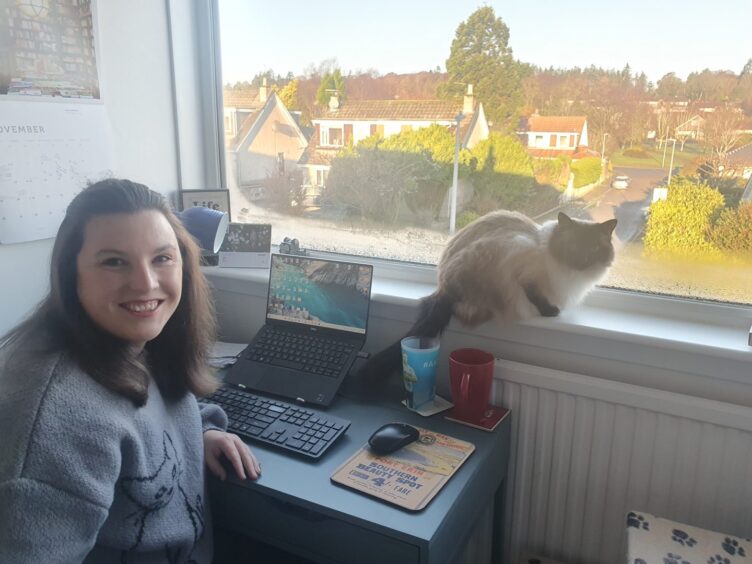To increase the risk of heart disease, a whole host of unhealthy habits come to mind – namely a lot of fatty fast foods.
But it turns out, you can up your chances of this and more by just working from home.
In a study from MindGym and non-profit, the Longevity Forum, remote workers were warned their working structure could worsen their health.
Working by yourself all day for long uninterrupted periods can apparently erode energy levels and even change the way your brain works.
It can also weaken the immune system and increase the risk of illnesses like depression and dementia.
Not great news for a society spending less time in the office after having no choice for two years.
Of course, it depends very much on your working habits, routine and lifestyle but are the risks the same for a 50/50 approach?
In other words, where does that leave employees leading a hybrid lifestyle?
Hybrid working used to be a possible disadvantage for career progression
Before lockdown, hybrid and remote workers – working from home at least some of the time instead of the office – was known as tele-working.
It was something director of research of social sciences at Aberdeen University, Claire Wallace, looked into long before lockdown was a thing.
She found people used to work from home at least partially to pursue lifestyle interests outside of work.
Prof Wallace said: “That was quite difficult for employers to accept. They didn’t like it because they like to see their workers.”
However, for most of these workers the productivity was higher.
While Prof Wallace admitted this was partly down to people feeling guilty for working from home, it was also because less time was spent getting ready for work.
There were of course some cons to the lifestyle.
She said: “They missed out on gossip for example which often disadvantaged them.
“They missed out quite often on promotions and what was happening in the office.
“And women were disadvantaged because it was mainly single people or men who were able to benefit from this because if women worked from home, they might have small children.
“But then of course came Covid and then everybody had to work at home and that changed the whole dynamic.”
Being physically present with others at work tackles isolation
Post-lockdown, around 40-60% of UK and USA workers now want to work from home at least part-time.
But in a study from the Digital Futures at Work Research Centre, they warned employees can miss out on an essential element which is leading to increasing loneliness.
This element is something called daily sensory contact impact (DSC). The act of being physically present with people.
The study by Dr Almudena Cañibano, Dr Petros Chamakiotis and Dr Emma Russell argues this lack of in-person connection leads to lower wellbeing and a greater sense of detachment.
Prof Wallace added: “They argue it is very essential for workplaces.
“The people who didn’t get this were feeling very isolated and depressed. So the conclusion was this DSC is very necessary for managing workplaces and workplace wellbeing but it could be managed through hybrid working.
Is hybrid the perfect balance?
“Hybrid rather than remote working could enhance various relationships because it means you can still have contact.
“It helps to develop working relationships with other colleagues and also stimulates creativity.
“Their finding was this going into work is quite important but you haven’t got to be in work all the time.”
Prof Wallace also mentioned that for this to work, routine was shown to be important and having a space to work like an office.
During Covid, this was something a lot of people found hard with some using ironing boards as desks.
Although her space was more sharing the living room with her boyfriend, Jess Murphy senior account manager at Muckle Media – which has been certified as a Great Place to Work – in Aberdeen said it was trickier before she set up a study in the spare room.
It was the first time she had worked remotely for a job but Jess said she would not go back.
She said: “For me it’s transformed my work life balance with cutting down commuting times you’ve got more times in the evenings and even in the morning.”
What should companies be doing to support workers?
When speaking on the disadvantages of the lifestyle, Jess did say connectivity is a must.
“You’ve got to have the infrastructure internally to make sure you have the tools to connect you with your team and to make sure it works all smoothly,” she added.
“It’s not a personal con for me because I think Muckle handle it really well. We have regular team days where we’ll all connect in one city and have a fun team day.”
If she ever starts to feel a bit disconnected, she makes sure to go into the office more than once a week or call a colleague instead of sending a message.
Keeping a routine like going for a walk, taking regular breaks and doing at least one active thing outside of work also helps.
She admitted full remote working would be a step too far but for her it is an arrangement that works well and has increased her productivity.
Jess added: “I think also just having more of that personal autonomy and level of trust from management, that’s something that’s hugely important.
“I think hybrid remote is the perfect balance because you get that flexibility when you need it.
“I think we’re so lucky with the work life balance that we have and just how much Muckle thinks about that.”





Conversation